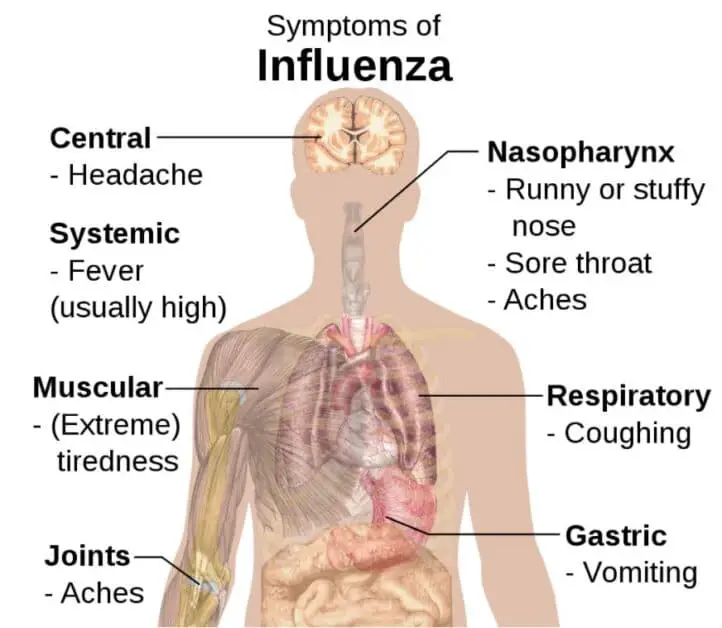
This article covers everything you need to know about the symptoms of flu in infants, children, and adults; what causes flu, how you get it, and how to prevent it. It also covers risk factors, complications of flu, and red flag signs that indicate you need to see your doctor.
We shall also explore the similarities between flu, common cold, and COVID-19.
Flu (influenza) is a highly contagious and seasonal respiratory disease caused by infection with influenza viruses.
There are four types of influenza viruses: influenza A virus (IAV), B (IBV), C (ICV), and D (IDV). The first three types — A, B, and C — cause illnesses ranging from mild to severe in humans when they infect the nose, throat, and lungs.
Type D viruses are found primarily in cattle and secondarily in small ruminants and pigs. They are not known to cause illness in humans.
What causes flu?
Influenza A and B are responsible for most cases of illness during seasonal flu epidemics. Illnesses caused by flu A and B can lead to complications, hospitalization, and sometimes death, especially in susceptible individuals.
Influenza A viruses are responsible for flu pandemics in humans. They also infect other animals such as birds, pigs, and horses. The most common strains (subtypes) of influenza type A viruses in humans are H1N1 and H3N2.
Type B, found primarily in humans, is active alongside type A during seasonal epidemics. It was previously thought that illness caused by infection with flu B tends to be milder than illness caused by flu A. However, a study by Su Su et al. reported there was no evidence that influenza B infection was less severe than A.
Type C viruses are found in humans, pigs, camels, and dogs but only cause mild illness in humans (Mishin et al.), and infected individuals may show no symptoms. However, Njouom et al. recently reported severe cases of influenza C virus infection in children.
How do you get flu?

Infected people transmit the viruses through tiny respiratory droplets and aerosols they discharge or spray into the air around them when they talk, cough, sneeze, and kiss. You may get infected by inhaling virus-infected droplets or aerosols through your nose or mouth.
Infected people may pass the virus when they use their hands to touch or wipe their noses and then touch other people.
You may also get infected by touching surfaces or objects (toys, furniture, doorknobs, computer keyboards) contaminated with infected respiratory droplets or bodily fluids and then touching your mucus membranes (the linings of your nose, mouth, eyes) with your fingers.
Anyone, regardless of age, can get the flu and spread it. But it is more common among school-age children because it spreads faster in crowded places.
Symptoms of flu you need to know

Flu follows a seasonal pattern. The flu season starts in the fall and ends in spring. The infection spreads quickly among school children early in the flu season, and many school children have to stay at home due to illness. Parents living with infected children may then contract the illness from their children and spread it to other adults at their workplaces.
Tokars et al. estimated that during 2010-2016, an average of 8% of U.S. residents experienced symptomatic influenza. The estimate included both the vaccinated and unvaccinated, and people who sought medical attention and those who did not. The percentage varied between 3%-11% between the seasons.
Influenza is usually self-limiting in healthy individuals with healthy immune systems. Most healthy people recover within a week without developing flu-related complications. However, in high-risk groups, the illness may run a severe course. Serious complications may also develop, leading to hospitalization and sometimes death.
People who belong to high-risk groups need to seek prompt treatment. Thus, if you, your child, or a close relative are at risk of serious flu illness, you need to know the early signs and symptoms so that you can seek prompt medical attention.
Early signs and symptoms of the flu

An infected person may start to show signs and symptoms of the illness as early as 2 days after infection, but the incubation period may vary from 1 to 4 days (Ghebrehewet et al.). People with flu can spread it to others even before they have symptoms. Infected individuals are most contagious during the first 3 to 4 days after symptoms appear, but they may be contagious as early as a day before symptoms appear and up to 7 days after.
Some children remain contagious for longer.
Flu typically runs its course in about a week in most healthy individuals, but patients may need an extra week of rest to recover their strength, while some may need even longer.
Symptoms of flu may be mild, moderate, or severe. Here are the most commonly reported signs and symptoms of flu, according to Ghebrehewet et al.
- Fever with a sudden onset (may be => 103 degrees Fahrenheit (39.5 °C) (El-Radhi)
- Chills and shakes
- Runny nose or nasal congestion (rhinorrhea)
- Sore throat
- Cough (often dry cough)
- Muscle aches and pain (myalgia)
- Joint pains
- Headache
- Malaise, weakness, and fatigue
Symptoms of flu in children

In addition to the symptoms of flu listed above, school-age children may also have the following symptoms :
- Higher temperatures than in adults (> than 103 degrees Fahrenheit or 39.5 °C)
- May have febrile seizures or convulsions
- Earaches
- Cough and rhinorrhoea (runny nose) are common in children (Ruf et al.)
- Red, watery eyes
- Inflammation of mucus membranes (coryza or rhinitis) (Friedman et al.)
- Loss of appetite
- Diarrhea
- Nausea
- Vomiting
- Abdominal or stomach pain
- Dehydration
- Myalgias are less common in children (Ruf et al.), but occasionally, muscle problems may cause leg and back pain

Newborns and infants may show no symptoms besides fever.
Similarities and differences between flu and common cold

Cold is caused by viruses, such as rhinoviruses, coronaviruses, and adenoviruses.
The early symptoms of flu are similar to those of cold. Thus, flu may easily be mistaken for a cold at the onset. Flu and cold share many symptoms, but flu symptoms tend to be more severe and last longer than cold symptoms.
Here are some differences between the symptoms of cold and flu (Eccles):
- Flu symptoms tend to start more abruptly than cold symptoms
- You may experience cough and chest discomfort of mild to moderate severity with cold, but it is more severe with flu
- Fever is common in flu and may last up to 4 days, but rare in cold
- You may have chills with a cold, but it is more common with flu; flu chills also tend to be more severe
- Sore throat is more frequently reported with cold than flu
- You may have muscle and joint aches and pains with both flu or cold, but it is more frequently reported with flu and tends to be more severe
- Sneezing is more likely with cold than with flu
- Runny or stuffy nose occurs more frequently with cold than with flu.
- You are more likely to have headaches with the flu
- Cold sometimes causes fatigue, but you are more likely to experience severe fatigue, weakness, or lethargy when you have the flu
Eccles reported that a combination of cough and fever was probably the best predictor of flu.
Similarities and differences between flu and COVID-19

Flu and COVID-19 are both viral respiratory illnesses. But flu is caused by influenza viruses, while COVID-19 is caused by a virus first identified in 2019 and named severe acute respiratory syndrome coronavirus 2 (SARS-CoV-2).
Both viral illnesses are highly contagious, but COVID-19 is more contagious than flu, according to CDC.
Although a high percentage of people infected with COVID-19 remain asymptomatic (Ma et al.), COVID-19 may cause illness that is potentially more serious than flu in some patients. While people with flu start experiencing symptoms 1-4 days after infection, the incubation period of COVID-19 may be longer. People with COVID-19 may also remain contagious for longer periods.
Czubak et al. reported that cough, fever, headaches, muscle aches, and pains were frequently reported COVID-19 symptoms. According to the authors:
- Fever occurred at a higher rate with COVID-19 than with flu
- Cough was more common with flu than with COVID-19
- Headache was more likely with flu
- Muscular pain was more frequently reported with flu
- Sore throat was more common with flu and rarely reported with COVID-19
- Rhinorrhea (runny nose) was also more frequent with flu
Despite the differences in the incidence of some symptoms, flu and COVID-19 are very similar, and doctors can’t always distinguish between the two illnesses only through clinical signs and symptoms (Fistera et al.).

However, several studies have attempted to develop diagnostic models for differentiating flu from COVID-19.
Ding-Feng et al. reported that “fatigue, ground-glass opacity (anatomically ill-defined or hazy areas that may appear in high-resolution CT scans of the lungs ), and a higher level of albumin tend to be helpful for diagnosis of COVID-19 pneumonia, while older age, higher temperature, and a higher level of monocyte count tend to be helpful for the diagnosis of influenza A pneumonia.”
Li et al. developed a diagnostic model for differentiating COVID-19 from influenza that consisted of five variables: age, dry cough, fever, white cell count, and D-dimer (a protein fragment resulting when a blood clot dissolves in the blood). The authors reported that the five variables may help distinguish flu from COVID-19. Patients with high scores were more likely to have COVID-19, while patients with a low score were more likely to have influenza, according to the authors.
Thein et al. reported that shortness of breath and diarrhea were the strongest predictors of COVID-19 in their model.
Despite the efforts to develop diagnostic models for differentiating flu from COVID-19, the CDC reported that testing remains the most reliable way to distinguish the infections.
Flu risk factors
Anyone can get flu, but some people are at a higher risk of developing complications related to flu illness than others.
People at a high risk of flu-related complications include:
1. At-risk groups: Infants and young children less than 5 years

Children less than 5 years, especially children less than 2, had a high risk of flu-related complications (Willis et al., Ruf et al.).
Infants less than 6 months had the highest risk in the less-than-5 group (MacDonald et al.). Infants (< 6 months old) had higher rates of hospitalization, longer periods of stay at hospital ICUs, and higher death rates than “almost any other age group,” the authors reported.
Bhat et al. also reported that infants less than 6 months had the highest mortality rates among children younger than 18.
Children under 5 had a higher rate of influenza‐associated hospitalizations than the elderly (>65 years), according to Willis et al.
2. At-risk groups: Young people under 18

Younger people under 18 were at a higher risk of symptomatic flu than older adults (65 years and older), according to Tokars et al.
The authors reported incidence rates of symptomatic illness (vaccinated and unvaccinated individuals) of 9.3% for children (0-17years), 8.8% for adults (18-64), and 3.9% for adults 65 and older.
3. At-risk groups: Adults older than 65 years
Studies indicate that the elderly have a higher risk of developing life-threatening flu-related complications and mortality than children aged 0-17 years.
According to CDC, older adults (65 years and older) are at a higher risk of developing life-threatening flu-related complications than healthy young adults. The higher risk is due partly to a relatively weak immune system. Older people are also more likely to have chronic health problems (heart disease, diabetes) that make them more susceptible to severe complications. CDC estimated that older adults account for 50%-70% of seasonal flu-related hospitalizations and 70%-80% of seasonal flu-related deaths.
Quandelacy et al. reported that adults older than 75 years had the highest annual death rates due to influenza.
4. Other at-risk groups

Other at-risk groups include unvaccinated individuals, adults with chronic medical conditions (asthma, lung disease, heart disease, and diabetes), and people who have weakened immune systems (Ghebrehewet et al.)
Below is a summary of factors that increase the risk of developing life-threatening flu-related complications:
- People with chronic medical conditions, such as diabetes, chronic kidney disease, heart disease, and stroke
- Chronic respiratory and lung diseases (asthma, COPD, bronchiectasis, cystic fibrosis)
- Morbid obesity
- Severe anemia (including sickle cell anemia, pernicious anemia, and iron deficiency anemia)
- Diseases that lower immunity, such as HIV-AIDS, or treatments that suppress immunity (steroids, chemotherapy)
- Liver disorders
- People with cancer
- Children and adolescents (<19 years) who are on long-term aspirin therapy
- Children with neurologic conditions
- Pregnant women are also at a higher risk of complicated flu illness
- Socially and economically disadvantaged groups (racial and ethnic minorities)
- People living in nursing homes and long-term care facilities
Complications of flu

Flu-related complications that may develop in at-risk individuals include (Ghebrehewet et al.)
1. Respiratory complications
- Pneumonia is one of the most common complications of flu. It is a leading cause of mortality in the U.S. Influenza virus alone or with secondary bacterial infection may cause pneumonia, especially in at-risk individuals.
- Acute respiratory distress syndrome (ARDS) is characterized by acute non-cardiogenic pulmonary edema (non-heart disease-related congestion and swelling of the lungs due to fluids accumulating in the air sacs), leading to hypoxemia (low levels of blood oxygen) and an increased risk of respiratory failure
- Bronchitis: Inflammation of the linings of the bronchial tubes
- Sinusitis: Sinus infection and inflammation
- Worsening of chronic asthma: Flu may exacerbate chronic lung diseases, such as asthma, COPD, bronchiectasis, and cystic fibrosis
2. Cardiac complications
- Worsening of preexisting cardiovascular disease
- Myocarditis: Inflammation of the heart
- Pericarditis: Inflammation of the thin, fluid-filled membrane (pericardium) surrounding the heart
3. Neurological complications
- Febrile convulsions, especially in children
- Reye’s syndrome: A rare but life-threatening condition in infants and children that causes brain damage and dysfunction (encephalopathy) and fatty liver failure; it typically occurs after recovery from a viral illness
- Meningitis: Inflammation of the membranes (meninges) protecting the brain and spinal cord is usually due to a bacterial or viral infection
- Encephalitis: Inflammation of brain tissue due to an infection or autoimmune response
- Transverse myelitis (TM): Inflammatory condition of the spinal cord
- Guillain-Barré syndrome is an autoimmune disorder in which the immune system attacks and damages the nerves; often triggered by an infection
4. Musculoskeletal complications:
Myositis: Inflammation of skeletal muscles that causes pain and weakness
Rhabdomyolysis is a serious condition caused by muscle injury
5. Pregnancy-related complications

- Maternal complications
- Infant perinatal mortality: Death of a fetus or neonate (newborn)
- Increased risk of premature birth
- Small neonatal size
- Lower birth weight
6. Other complications of flu
- Multi-organ failure (lungs and kidneys)
- Sepsis due to the flu virus triggering an inflammatory response
Complications of flu in children
Complications of flu that may occur in children include:
- Croup (laryngotracheitis) is caused by viral infection of the respiratory tract (larynx, trachea, and bronchi) in young children (6 months to 3 years of age); causes swelling, inflammation of the upper airway, and obstruction leading to breathing difficulties (Bjornson et al., Smith et al.); characterized by a harsh cough, hoarse voice, stridor (noisy breathing), and respiratory distress (Ortiz-Alvarez)
- Otitis media is inflammation of the middle ear common in children
- Sinusitis: Inflammation of tissues lining the sinuses (the sinuses are air-filled spaces near the eyes and on both sides of the nose)
- Dehydration: Loss of body fluids and electrolytes
- Febrile convulsions are most common in children
- Encephalitis (brain inflammation)
- Encephalopathy: Brain damage that may cause seizures, confusion, or unresponsiveness
When to see your doctor: Red flag signs and symptoms of flu

See your doctor immediately if you, your child, or a relative develop any of the following signs and symptoms:
- A persistent cough that doesn’t go away after a bout of flu illness, or
- Fever or cough that improves then relapses or gets worse
- Coughing up greenish, yellowish, or bloody sputum
- High fever above 104°F
- Cyanosis: Bluish face or lips
- Trouble or difficulty breathing, shortness of breath, or fast breathing
- Persistent chest pain or feeling of pressure in the chest
- Abdominal pain or feeling of pressure
- Extreme fatigue, weakness, or unsteadiness
- Severe muscle pain that results in walking difficulties, limping, or inability to move
- When a child refuses to drink, shows signs of dehydration, reduction in urine output, dry mouth, and no tears
- Dizziness
- Changes in consciousness, alertness, or unresponsiveness
- Stiff neck
- Seizure or convulsions
- Confusion
- Severe vomiting
- Worsening of preexisting medical condition
- Any signs indicative of developing complications (see complications of flu above)
- Constant irritability and listlessness in infants, or crying
You need to see your doctor promptly if you are at a high risk of severe illness regardless of danger signs (see risk factors above). You also need to treat flu promptly if you or your child are on a medication that suppresses immunity, such as acetylsalicylic acid (ASA or Aspirin).
Flu prevention and treatment

Getting vaccinated every year is the best way to protect yourself against seasonal flu and reduce the risk of serious complications if you get it (Chow et al., Santibanez et al.).
Health authorities recommend annual vaccination for everyone 6 months and older to prevent flu. Children younger than 6 months cannot receive the vaccination. Therefore, care providers and other close contacts should get vaccinated (Santibanez et al.).
You should get vaccinated every year because influenza viruses mutate (change) constantly, and new virulent strains are emerging faster than your immune system can adapt. Vaccination helps your immune system keep up with the fast rate of genetic change of the viruses.
Practicing proper hygiene (such as handwashing) and avoiding contact with people with flu also helps prevent illness (Hill et al.).
People who have flu need plenty of rest and fluids. Minimizing stress, getting enough physical exercise, and a healthy diet are measures that reduce your risk of getting sick with the flu.
A healthy diet should supply enough carbs for energy, proteins for the repair of body tissues, and fiber for digestive health.
Sick people should isolate and avoid contact with other people, especially people at a high risk of illness and complications.
A note to our readers on flu treatment

This article is meant only for informational purposes and not as a substitute for advice and care by a qualified medical professional or healthcare provider. We strongly advise you to consult your healthcare provider if you believe you or your child has flu symptoms.
If your doctor determines that you are at a high risk of severe flu illness or complications, he may prescribe antiviral drugs, such as oseltamivir phosphate (Tamiflu), zanamivir (Relenza), peramivir (Rapivab), and baloxavir marboxil (Xofluza) (Hill et al.)
Antivirals shorten the duration and severity of flu illness and may also help lower the risk of developing complications. However, they are most effective when flu is diagnosed early (within 48 hours of the onset of symptoms) (Lehnert et al. ) and preferable within 24 hours (Gaitonde et al.)
Your doctor may also recommend tests, such as rapid influenza diagnostic tests (RIDTs) (Green et al.) or the more accurate rapid molecular assays if they think it is necessary.
Other types of tests include reverse transcription-polymerase chain reaction (RT-PCR), viral culture, and immunofluorescence assays.

